Research Proposal: Impact of Electronic Gadgets on Human Wellbeing
VerifiedAdded on 2020/05/04
|13
|2957
|1025
Project
AI Summary
This research proposal investigates the relationship between the increasing reliance on electronic gadgets and their effects on human mental and physical health. The study aims to quantitatively analyze the impact of digital tools, assess the dependency of children on these gadgets, and examine the negative health consequences associated with their use. The proposal outlines a research methodology involving a survey of 50 customers from an electronics store, incorporating both closed and open-ended questions. The research will employ an explanatory research design, utilizing a case study approach and analyzing primary data through statistical methods like correlation and regression. The findings are intended to contribute empirically to the understanding of how electronic gadget usage affects human wellbeing, addressing limitations such as sample size and potential ambiguities in children's responses. The study will use both primary and secondary data for its analysis, aiming to provide insights into the effects of technology on individuals of different ages.
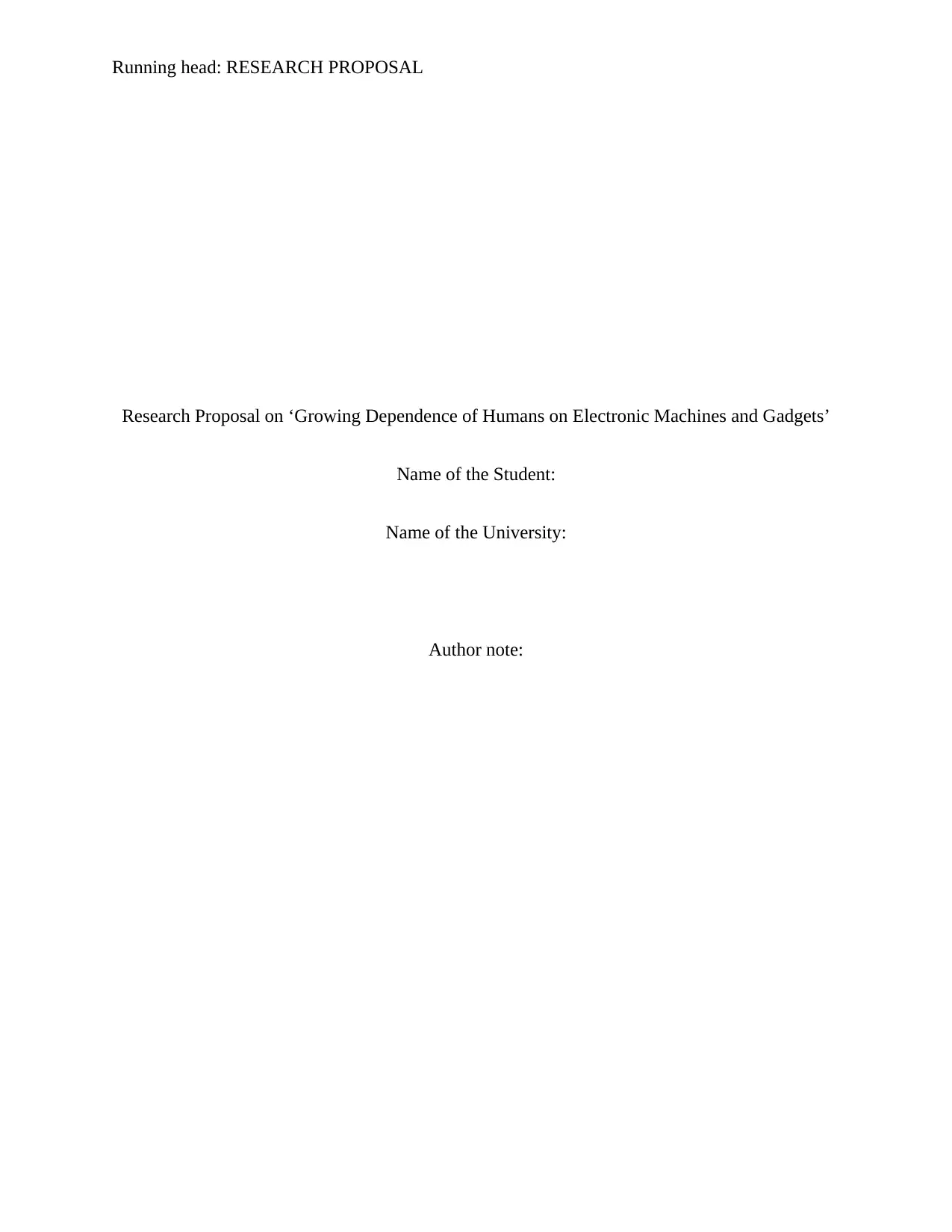
Running head: RESEARCH PROPOSAL
Research Proposal on ‘Growing Dependence of Humans on Electronic Machines and Gadgets’
Name of the Student:
Name of the University:
Author note:
Research Proposal on ‘Growing Dependence of Humans on Electronic Machines and Gadgets’
Name of the Student:
Name of the University:
Author note:
Paraphrase This Document
Need a fresh take? Get an instant paraphrase of this document with our AI Paraphraser
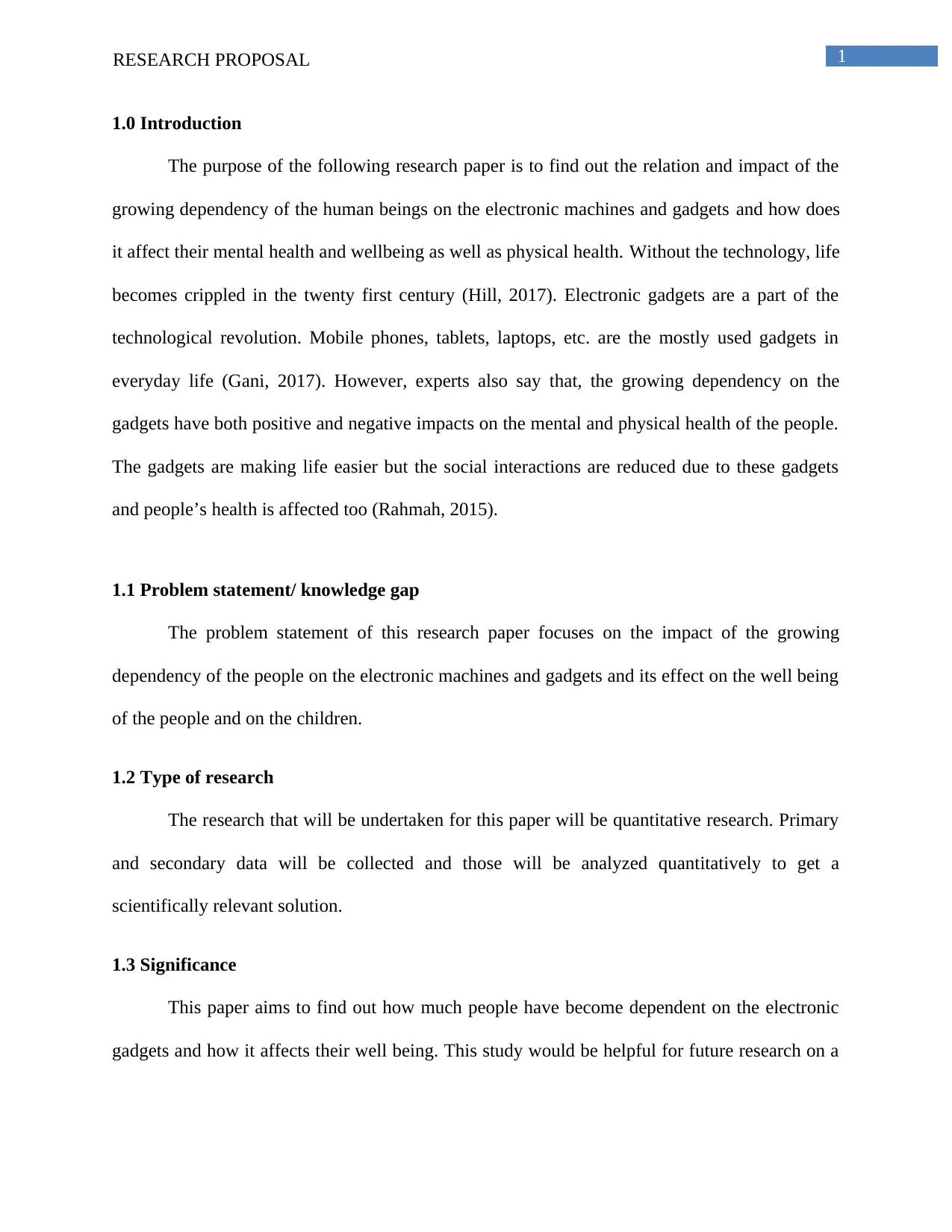
1RESEARCH PROPOSAL
1.0 Introduction
The purpose of the following research paper is to find out the relation and impact of the
growing dependency of the human beings on the electronic machines and gadgets and how does
it affect their mental health and wellbeing as well as physical health. Without the technology, life
becomes crippled in the twenty first century (Hill, 2017). Electronic gadgets are a part of the
technological revolution. Mobile phones, tablets, laptops, etc. are the mostly used gadgets in
everyday life (Gani, 2017). However, experts also say that, the growing dependency on the
gadgets have both positive and negative impacts on the mental and physical health of the people.
The gadgets are making life easier but the social interactions are reduced due to these gadgets
and people’s health is affected too (Rahmah, 2015).
1.1 Problem statement/ knowledge gap
The problem statement of this research paper focuses on the impact of the growing
dependency of the people on the electronic machines and gadgets and its effect on the well being
of the people and on the children.
1.2 Type of research
The research that will be undertaken for this paper will be quantitative research. Primary
and secondary data will be collected and those will be analyzed quantitatively to get a
scientifically relevant solution.
1.3 Significance
This paper aims to find out how much people have become dependent on the electronic
gadgets and how it affects their well being. This study would be helpful for future research on a
1.0 Introduction
The purpose of the following research paper is to find out the relation and impact of the
growing dependency of the human beings on the electronic machines and gadgets and how does
it affect their mental health and wellbeing as well as physical health. Without the technology, life
becomes crippled in the twenty first century (Hill, 2017). Electronic gadgets are a part of the
technological revolution. Mobile phones, tablets, laptops, etc. are the mostly used gadgets in
everyday life (Gani, 2017). However, experts also say that, the growing dependency on the
gadgets have both positive and negative impacts on the mental and physical health of the people.
The gadgets are making life easier but the social interactions are reduced due to these gadgets
and people’s health is affected too (Rahmah, 2015).
1.1 Problem statement/ knowledge gap
The problem statement of this research paper focuses on the impact of the growing
dependency of the people on the electronic machines and gadgets and its effect on the well being
of the people and on the children.
1.2 Type of research
The research that will be undertaken for this paper will be quantitative research. Primary
and secondary data will be collected and those will be analyzed quantitatively to get a
scientifically relevant solution.
1.3 Significance
This paper aims to find out how much people have become dependent on the electronic
gadgets and how it affects their well being. This study would be helpful for future research on a

2RESEARCH PROPOSAL
relevant topic and would also help in finding out more ways to improve quality of life through
the adoption of the positive impacts of electronic gadgets.
1.4 Research objectives
The objectives of the research paper are:
To critically analyze the impact of digital tools on the human beings
To evaluate the dependency of the children on the electronic gadgets and its impact on
them
To find out and examine the negative impact of the gadgets on human health
To assess the addiction of people towards the electronic gadgets
1.5 Research questions
1. What is the overall impact of the electronic gadgets on the daily life of people?
2. How the children are dependent on the electronic gadgets and what are the impacts on
them?
3. What are the negative impacts of the dependency on the electronic gadgets on the human
health?
relevant topic and would also help in finding out more ways to improve quality of life through
the adoption of the positive impacts of electronic gadgets.
1.4 Research objectives
The objectives of the research paper are:
To critically analyze the impact of digital tools on the human beings
To evaluate the dependency of the children on the electronic gadgets and its impact on
them
To find out and examine the negative impact of the gadgets on human health
To assess the addiction of people towards the electronic gadgets
1.5 Research questions
1. What is the overall impact of the electronic gadgets on the daily life of people?
2. How the children are dependent on the electronic gadgets and what are the impacts on
them?
3. What are the negative impacts of the dependency on the electronic gadgets on the human
health?
⊘ This is a preview!⊘
Do you want full access?
Subscribe today to unlock all pages.

Trusted by 1+ million students worldwide
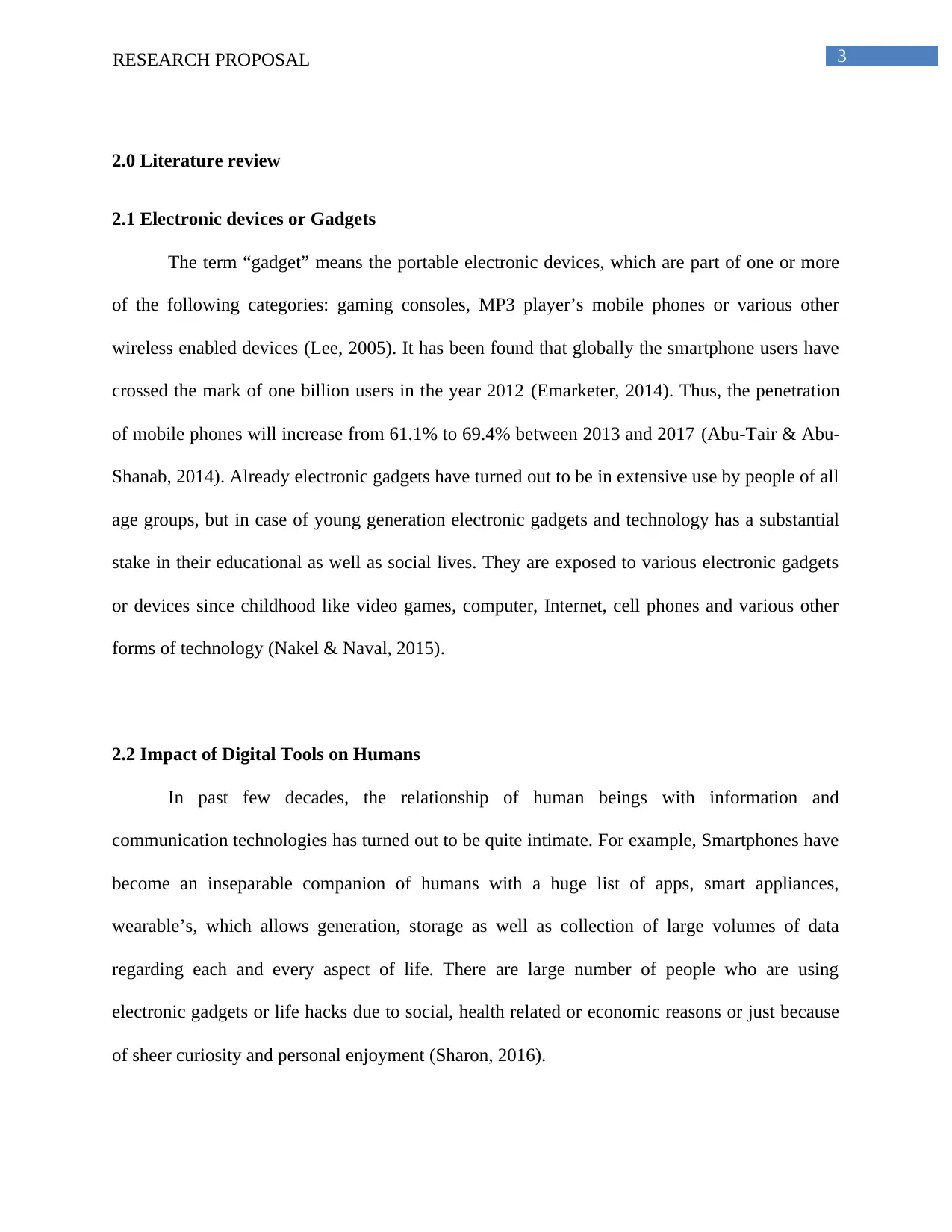
3RESEARCH PROPOSAL
2.0 Literature review
2.1 Electronic devices or Gadgets
The term “gadget” means the portable electronic devices, which are part of one or more
of the following categories: gaming consoles, MP3 player’s mobile phones or various other
wireless enabled devices (Lee, 2005). It has been found that globally the smartphone users have
crossed the mark of one billion users in the year 2012 (Emarketer, 2014). Thus, the penetration
of mobile phones will increase from 61.1% to 69.4% between 2013 and 2017 (Abu-Tair & Abu-
Shanab, 2014). Already electronic gadgets have turned out to be in extensive use by people of all
age groups, but in case of young generation electronic gadgets and technology has a substantial
stake in their educational as well as social lives. They are exposed to various electronic gadgets
or devices since childhood like video games, computer, Internet, cell phones and various other
forms of technology (Nakel & Naval, 2015).
2.2 Impact of Digital Tools on Humans
In past few decades, the relationship of human beings with information and
communication technologies has turned out to be quite intimate. For example, Smartphones have
become an inseparable companion of humans with a huge list of apps, smart appliances,
wearable’s, which allows generation, storage as well as collection of large volumes of data
regarding each and every aspect of life. There are large number of people who are using
electronic gadgets or life hacks due to social, health related or economic reasons or just because
of sheer curiosity and personal enjoyment (Sharon, 2016).
2.0 Literature review
2.1 Electronic devices or Gadgets
The term “gadget” means the portable electronic devices, which are part of one or more
of the following categories: gaming consoles, MP3 player’s mobile phones or various other
wireless enabled devices (Lee, 2005). It has been found that globally the smartphone users have
crossed the mark of one billion users in the year 2012 (Emarketer, 2014). Thus, the penetration
of mobile phones will increase from 61.1% to 69.4% between 2013 and 2017 (Abu-Tair & Abu-
Shanab, 2014). Already electronic gadgets have turned out to be in extensive use by people of all
age groups, but in case of young generation electronic gadgets and technology has a substantial
stake in their educational as well as social lives. They are exposed to various electronic gadgets
or devices since childhood like video games, computer, Internet, cell phones and various other
forms of technology (Nakel & Naval, 2015).
2.2 Impact of Digital Tools on Humans
In past few decades, the relationship of human beings with information and
communication technologies has turned out to be quite intimate. For example, Smartphones have
become an inseparable companion of humans with a huge list of apps, smart appliances,
wearable’s, which allows generation, storage as well as collection of large volumes of data
regarding each and every aspect of life. There are large number of people who are using
electronic gadgets or life hacks due to social, health related or economic reasons or just because
of sheer curiosity and personal enjoyment (Sharon, 2016).
Paraphrase This Document
Need a fresh take? Get an instant paraphrase of this document with our AI Paraphraser
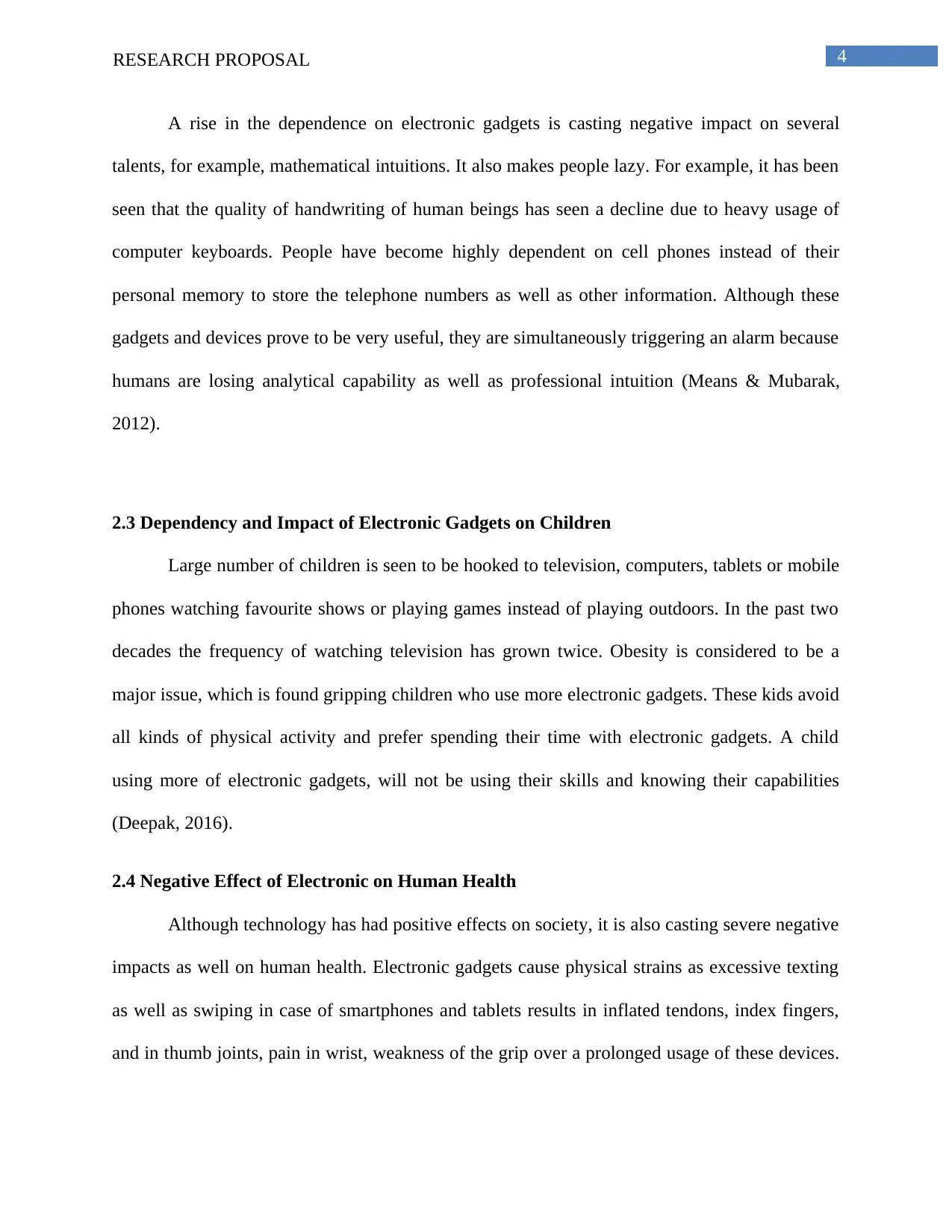
4RESEARCH PROPOSAL
A rise in the dependence on electronic gadgets is casting negative impact on several
talents, for example, mathematical intuitions. It also makes people lazy. For example, it has been
seen that the quality of handwriting of human beings has seen a decline due to heavy usage of
computer keyboards. People have become highly dependent on cell phones instead of their
personal memory to store the telephone numbers as well as other information. Although these
gadgets and devices prove to be very useful, they are simultaneously triggering an alarm because
humans are losing analytical capability as well as professional intuition (Means & Mubarak,
2012).
2.3 Dependency and Impact of Electronic Gadgets on Children
Large number of children is seen to be hooked to television, computers, tablets or mobile
phones watching favourite shows or playing games instead of playing outdoors. In the past two
decades the frequency of watching television has grown twice. Obesity is considered to be a
major issue, which is found gripping children who use more electronic gadgets. These kids avoid
all kinds of physical activity and prefer spending their time with electronic gadgets. A child
using more of electronic gadgets, will not be using their skills and knowing their capabilities
(Deepak, 2016).
2.4 Negative Effect of Electronic on Human Health
Although technology has had positive effects on society, it is also casting severe negative
impacts as well on human health. Electronic gadgets cause physical strains as excessive texting
as well as swiping in case of smartphones and tablets results in inflated tendons, index fingers,
and in thumb joints, pain in wrist, weakness of the grip over a prolonged usage of these devices.
A rise in the dependence on electronic gadgets is casting negative impact on several
talents, for example, mathematical intuitions. It also makes people lazy. For example, it has been
seen that the quality of handwriting of human beings has seen a decline due to heavy usage of
computer keyboards. People have become highly dependent on cell phones instead of their
personal memory to store the telephone numbers as well as other information. Although these
gadgets and devices prove to be very useful, they are simultaneously triggering an alarm because
humans are losing analytical capability as well as professional intuition (Means & Mubarak,
2012).
2.3 Dependency and Impact of Electronic Gadgets on Children
Large number of children is seen to be hooked to television, computers, tablets or mobile
phones watching favourite shows or playing games instead of playing outdoors. In the past two
decades the frequency of watching television has grown twice. Obesity is considered to be a
major issue, which is found gripping children who use more electronic gadgets. These kids avoid
all kinds of physical activity and prefer spending their time with electronic gadgets. A child
using more of electronic gadgets, will not be using their skills and knowing their capabilities
(Deepak, 2016).
2.4 Negative Effect of Electronic on Human Health
Although technology has had positive effects on society, it is also casting severe negative
impacts as well on human health. Electronic gadgets cause physical strains as excessive texting
as well as swiping in case of smartphones and tablets results in inflated tendons, index fingers,
and in thumb joints, pain in wrist, weakness of the grip over a prolonged usage of these devices.
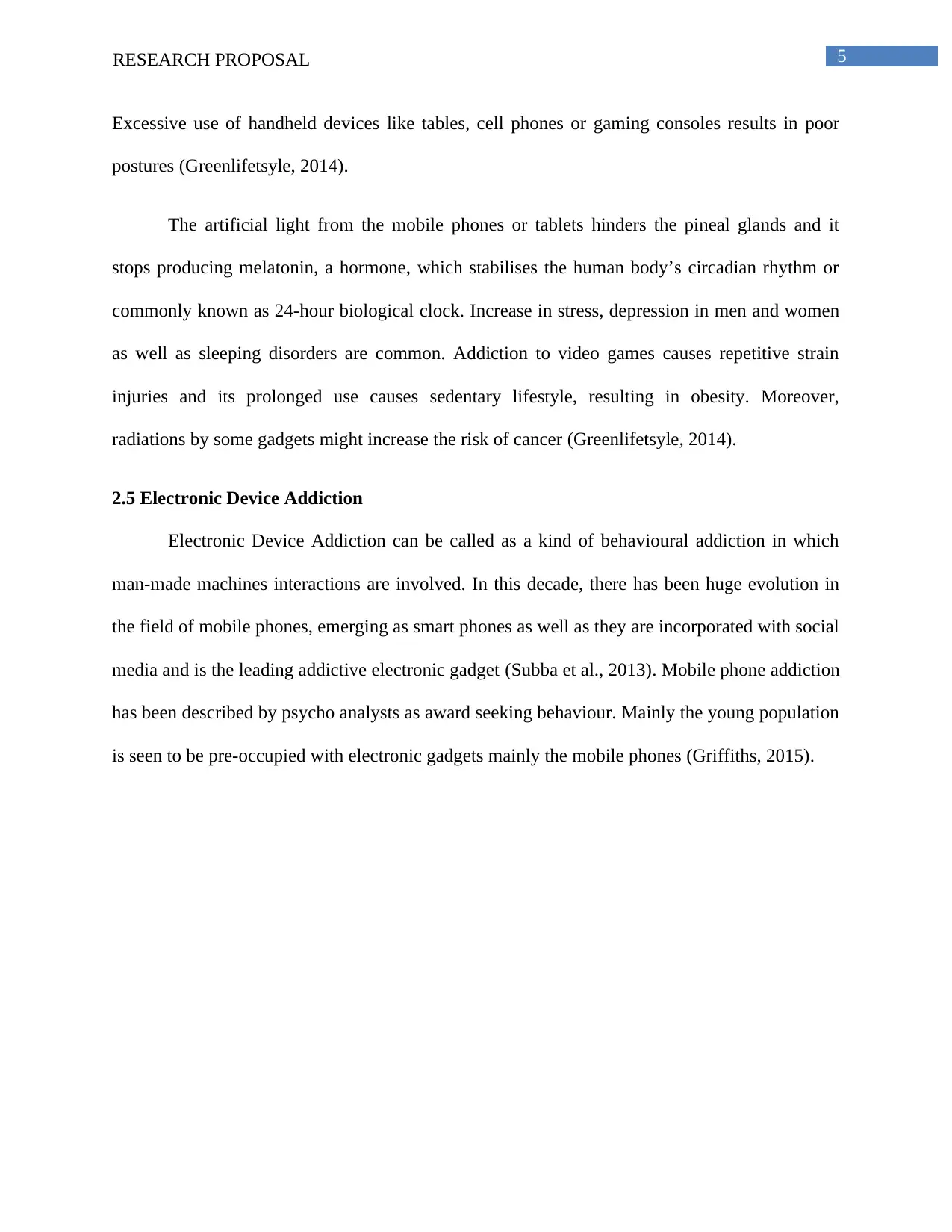
5RESEARCH PROPOSAL
Excessive use of handheld devices like tables, cell phones or gaming consoles results in poor
postures (Greenlifetsyle, 2014).
The artificial light from the mobile phones or tablets hinders the pineal glands and it
stops producing melatonin, a hormone, which stabilises the human body’s circadian rhythm or
commonly known as 24-hour biological clock. Increase in stress, depression in men and women
as well as sleeping disorders are common. Addiction to video games causes repetitive strain
injuries and its prolonged use causes sedentary lifestyle, resulting in obesity. Moreover,
radiations by some gadgets might increase the risk of cancer (Greenlifetsyle, 2014).
2.5 Electronic Device Addiction
Electronic Device Addiction can be called as a kind of behavioural addiction in which
man-made machines interactions are involved. In this decade, there has been huge evolution in
the field of mobile phones, emerging as smart phones as well as they are incorporated with social
media and is the leading addictive electronic gadget (Subba et al., 2013). Mobile phone addiction
has been described by psycho analysts as award seeking behaviour. Mainly the young population
is seen to be pre-occupied with electronic gadgets mainly the mobile phones (Griffiths, 2015).
Excessive use of handheld devices like tables, cell phones or gaming consoles results in poor
postures (Greenlifetsyle, 2014).
The artificial light from the mobile phones or tablets hinders the pineal glands and it
stops producing melatonin, a hormone, which stabilises the human body’s circadian rhythm or
commonly known as 24-hour biological clock. Increase in stress, depression in men and women
as well as sleeping disorders are common. Addiction to video games causes repetitive strain
injuries and its prolonged use causes sedentary lifestyle, resulting in obesity. Moreover,
radiations by some gadgets might increase the risk of cancer (Greenlifetsyle, 2014).
2.5 Electronic Device Addiction
Electronic Device Addiction can be called as a kind of behavioural addiction in which
man-made machines interactions are involved. In this decade, there has been huge evolution in
the field of mobile phones, emerging as smart phones as well as they are incorporated with social
media and is the leading addictive electronic gadget (Subba et al., 2013). Mobile phone addiction
has been described by psycho analysts as award seeking behaviour. Mainly the young population
is seen to be pre-occupied with electronic gadgets mainly the mobile phones (Griffiths, 2015).
⊘ This is a preview!⊘
Do you want full access?
Subscribe today to unlock all pages.

Trusted by 1+ million students worldwide
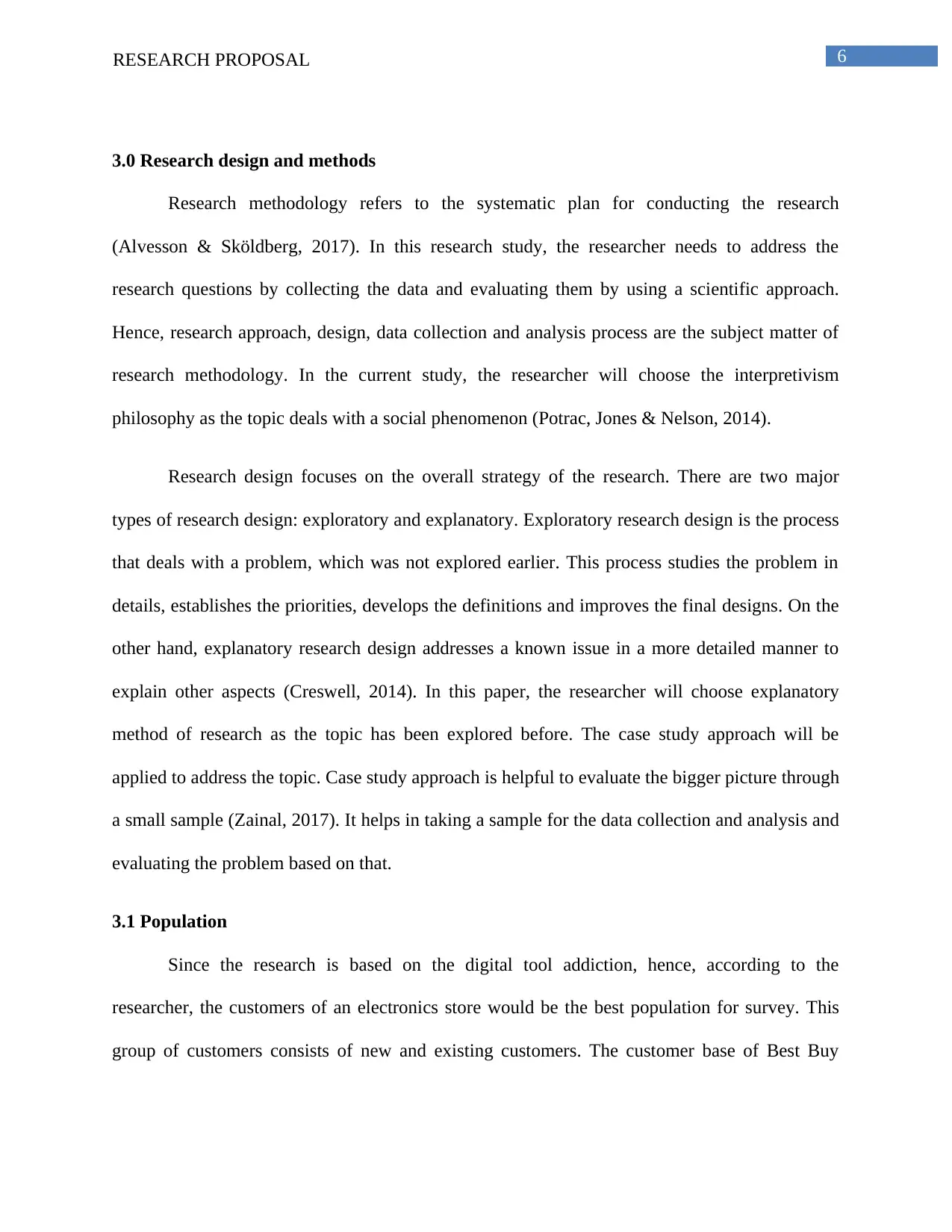
6RESEARCH PROPOSAL
3.0 Research design and methods
Research methodology refers to the systematic plan for conducting the research
(Alvesson & Sköldberg, 2017). In this research study, the researcher needs to address the
research questions by collecting the data and evaluating them by using a scientific approach.
Hence, research approach, design, data collection and analysis process are the subject matter of
research methodology. In the current study, the researcher will choose the interpretivism
philosophy as the topic deals with a social phenomenon (Potrac, Jones & Nelson, 2014).
Research design focuses on the overall strategy of the research. There are two major
types of research design: exploratory and explanatory. Exploratory research design is the process
that deals with a problem, which was not explored earlier. This process studies the problem in
details, establishes the priorities, develops the definitions and improves the final designs. On the
other hand, explanatory research design addresses a known issue in a more detailed manner to
explain other aspects (Creswell, 2014). In this paper, the researcher will choose explanatory
method of research as the topic has been explored before. The case study approach will be
applied to address the topic. Case study approach is helpful to evaluate the bigger picture through
a small sample (Zainal, 2017). It helps in taking a sample for the data collection and analysis and
evaluating the problem based on that.
3.1 Population
Since the research is based on the digital tool addiction, hence, according to the
researcher, the customers of an electronics store would be the best population for survey. This
group of customers consists of new and existing customers. The customer base of Best Buy
3.0 Research design and methods
Research methodology refers to the systematic plan for conducting the research
(Alvesson & Sköldberg, 2017). In this research study, the researcher needs to address the
research questions by collecting the data and evaluating them by using a scientific approach.
Hence, research approach, design, data collection and analysis process are the subject matter of
research methodology. In the current study, the researcher will choose the interpretivism
philosophy as the topic deals with a social phenomenon (Potrac, Jones & Nelson, 2014).
Research design focuses on the overall strategy of the research. There are two major
types of research design: exploratory and explanatory. Exploratory research design is the process
that deals with a problem, which was not explored earlier. This process studies the problem in
details, establishes the priorities, develops the definitions and improves the final designs. On the
other hand, explanatory research design addresses a known issue in a more detailed manner to
explain other aspects (Creswell, 2014). In this paper, the researcher will choose explanatory
method of research as the topic has been explored before. The case study approach will be
applied to address the topic. Case study approach is helpful to evaluate the bigger picture through
a small sample (Zainal, 2017). It helps in taking a sample for the data collection and analysis and
evaluating the problem based on that.
3.1 Population
Since the research is based on the digital tool addiction, hence, according to the
researcher, the customers of an electronics store would be the best population for survey. This
group of customers consists of new and existing customers. The customer base of Best Buy
Paraphrase This Document
Need a fresh take? Get an instant paraphrase of this document with our AI Paraphraser
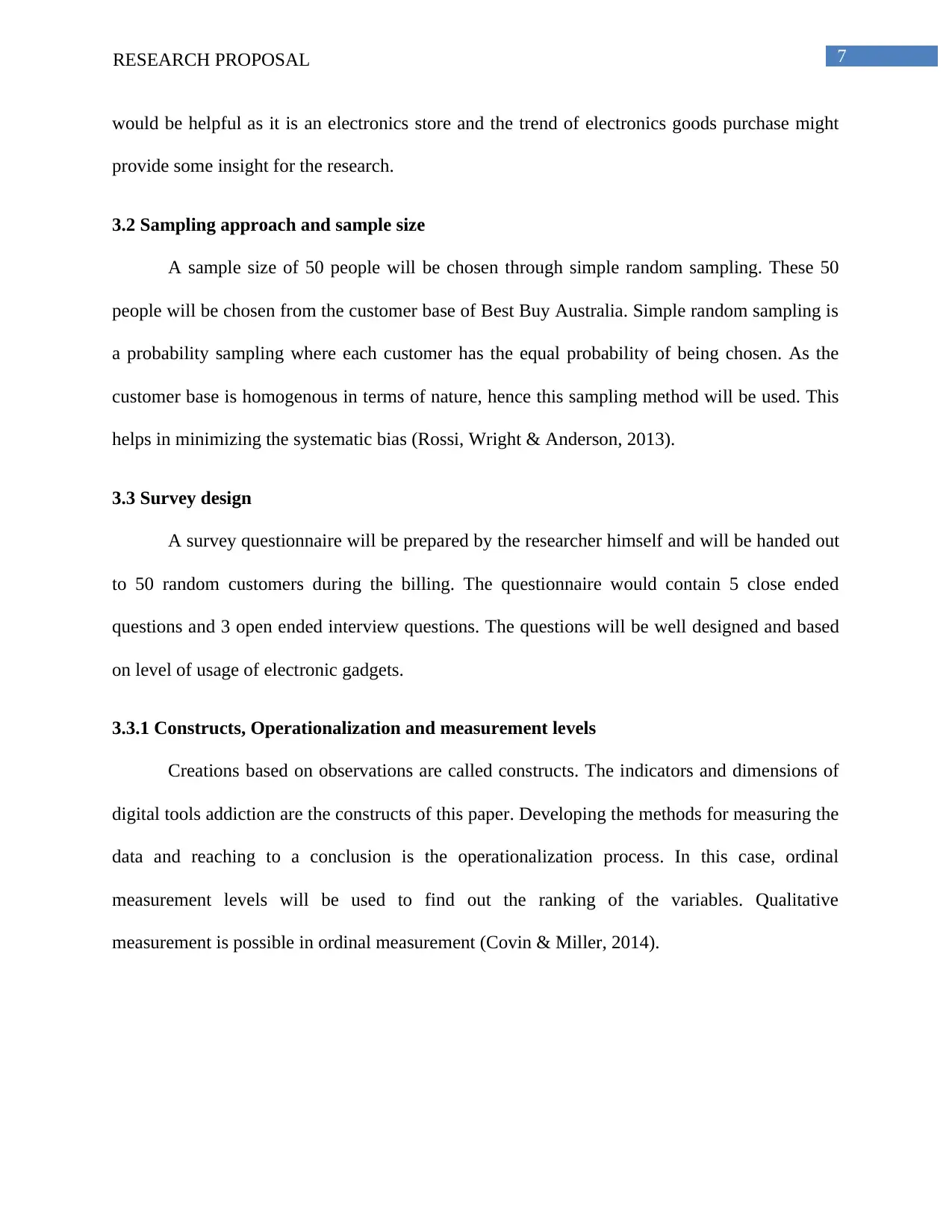
7RESEARCH PROPOSAL
would be helpful as it is an electronics store and the trend of electronics goods purchase might
provide some insight for the research.
3.2 Sampling approach and sample size
A sample size of 50 people will be chosen through simple random sampling. These 50
people will be chosen from the customer base of Best Buy Australia. Simple random sampling is
a probability sampling where each customer has the equal probability of being chosen. As the
customer base is homogenous in terms of nature, hence this sampling method will be used. This
helps in minimizing the systematic bias (Rossi, Wright & Anderson, 2013).
3.3 Survey design
A survey questionnaire will be prepared by the researcher himself and will be handed out
to 50 random customers during the billing. The questionnaire would contain 5 close ended
questions and 3 open ended interview questions. The questions will be well designed and based
on level of usage of electronic gadgets.
3.3.1 Constructs, Operationalization and measurement levels
Creations based on observations are called constructs. The indicators and dimensions of
digital tools addiction are the constructs of this paper. Developing the methods for measuring the
data and reaching to a conclusion is the operationalization process. In this case, ordinal
measurement levels will be used to find out the ranking of the variables. Qualitative
measurement is possible in ordinal measurement (Covin & Miller, 2014).
would be helpful as it is an electronics store and the trend of electronics goods purchase might
provide some insight for the research.
3.2 Sampling approach and sample size
A sample size of 50 people will be chosen through simple random sampling. These 50
people will be chosen from the customer base of Best Buy Australia. Simple random sampling is
a probability sampling where each customer has the equal probability of being chosen. As the
customer base is homogenous in terms of nature, hence this sampling method will be used. This
helps in minimizing the systematic bias (Rossi, Wright & Anderson, 2013).
3.3 Survey design
A survey questionnaire will be prepared by the researcher himself and will be handed out
to 50 random customers during the billing. The questionnaire would contain 5 close ended
questions and 3 open ended interview questions. The questions will be well designed and based
on level of usage of electronic gadgets.
3.3.1 Constructs, Operationalization and measurement levels
Creations based on observations are called constructs. The indicators and dimensions of
digital tools addiction are the constructs of this paper. Developing the methods for measuring the
data and reaching to a conclusion is the operationalization process. In this case, ordinal
measurement levels will be used to find out the ranking of the variables. Qualitative
measurement is possible in ordinal measurement (Covin & Miller, 2014).

8RESEARCH PROPOSAL
3.4 Mode of Data collection
The researcher will be collecting both the primary and secondary data for this research
study. Primary data is the one, which is collected directly from the field of study and secondary
data is the one that is collected from already published sources (Beer & Faulkner, 2014). In this
research study, the researcher will conduct a survey, focusing on the digital tools addiction and
its impacts on the adults and children.
For the secondary data, the researcher will look for the data on health problems, mental
issues, and the usage of electronic goods in daily lives. For that, the official websites of WHO
and other international health organizations and various health and technology journals will be
explored by the researcher. The official sales data of Best Buy Australia will also be taken to get
an idea about the sales of electronics goods.
3.5 Analytic method
The quantitative data analysis process will be used in this paper. The researcher will
analyze the primary data by using scientific methods, such as statistical tools of correlation,
regression, and frequency calculation. This minimizes any biasness and fluctuation in the
observation (Treiman, 2014). The secondary data and the interview responses will be used to
validate the results of primary data analysis.
3.4 Mode of Data collection
The researcher will be collecting both the primary and secondary data for this research
study. Primary data is the one, which is collected directly from the field of study and secondary
data is the one that is collected from already published sources (Beer & Faulkner, 2014). In this
research study, the researcher will conduct a survey, focusing on the digital tools addiction and
its impacts on the adults and children.
For the secondary data, the researcher will look for the data on health problems, mental
issues, and the usage of electronic goods in daily lives. For that, the official websites of WHO
and other international health organizations and various health and technology journals will be
explored by the researcher. The official sales data of Best Buy Australia will also be taken to get
an idea about the sales of electronics goods.
3.5 Analytic method
The quantitative data analysis process will be used in this paper. The researcher will
analyze the primary data by using scientific methods, such as statistical tools of correlation,
regression, and frequency calculation. This minimizes any biasness and fluctuation in the
observation (Treiman, 2014). The secondary data and the interview responses will be used to
validate the results of primary data analysis.
⊘ This is a preview!⊘
Do you want full access?
Subscribe today to unlock all pages.

Trusted by 1+ million students worldwide
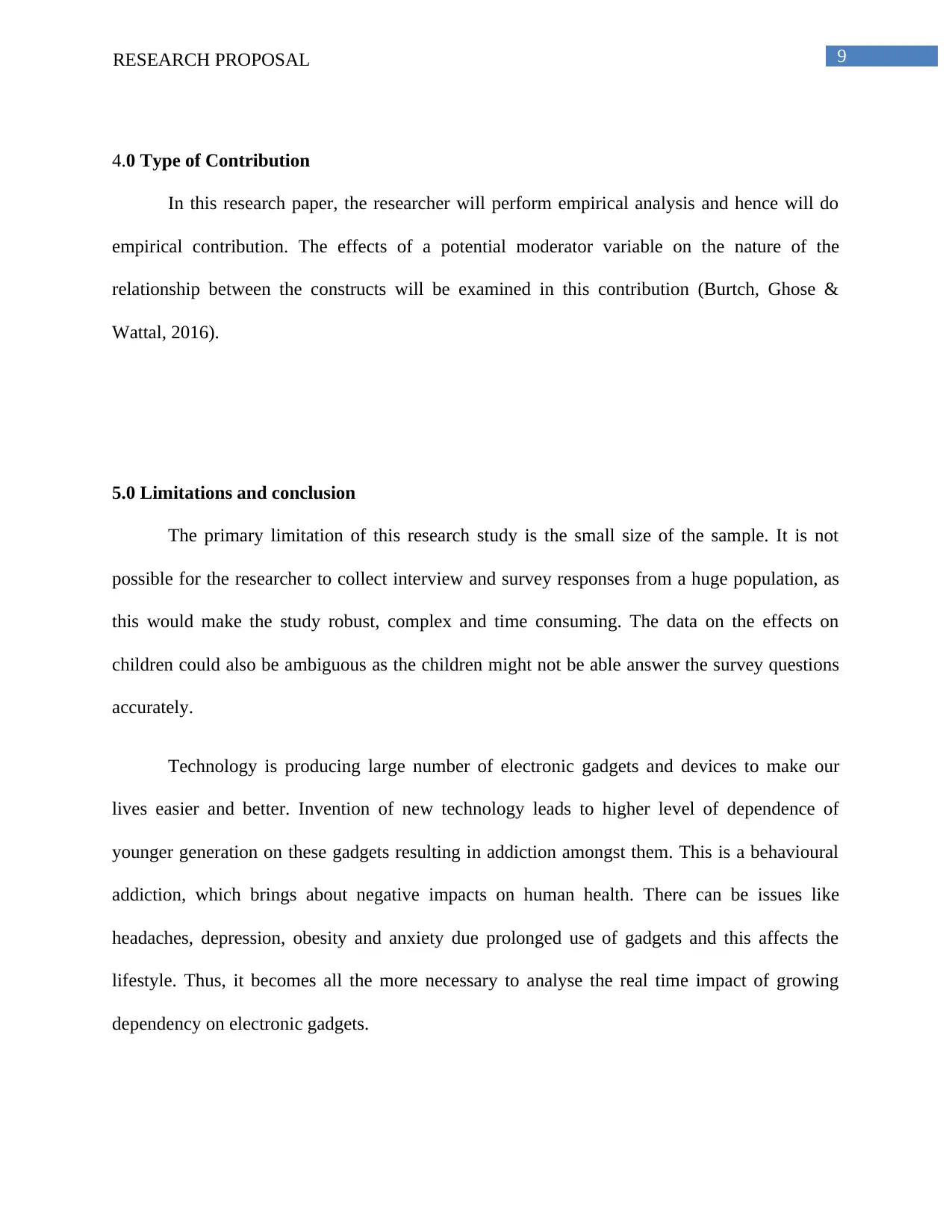
9RESEARCH PROPOSAL
4.0 Type of Contribution
In this research paper, the researcher will perform empirical analysis and hence will do
empirical contribution. The effects of a potential moderator variable on the nature of the
relationship between the constructs will be examined in this contribution (Burtch, Ghose &
Wattal, 2016).
5.0 Limitations and conclusion
The primary limitation of this research study is the small size of the sample. It is not
possible for the researcher to collect interview and survey responses from a huge population, as
this would make the study robust, complex and time consuming. The data on the effects on
children could also be ambiguous as the children might not be able answer the survey questions
accurately.
Technology is producing large number of electronic gadgets and devices to make our
lives easier and better. Invention of new technology leads to higher level of dependence of
younger generation on these gadgets resulting in addiction amongst them. This is a behavioural
addiction, which brings about negative impacts on human health. There can be issues like
headaches, depression, obesity and anxiety due prolonged use of gadgets and this affects the
lifestyle. Thus, it becomes all the more necessary to analyse the real time impact of growing
dependency on electronic gadgets.
4.0 Type of Contribution
In this research paper, the researcher will perform empirical analysis and hence will do
empirical contribution. The effects of a potential moderator variable on the nature of the
relationship between the constructs will be examined in this contribution (Burtch, Ghose &
Wattal, 2016).
5.0 Limitations and conclusion
The primary limitation of this research study is the small size of the sample. It is not
possible for the researcher to collect interview and survey responses from a huge population, as
this would make the study robust, complex and time consuming. The data on the effects on
children could also be ambiguous as the children might not be able answer the survey questions
accurately.
Technology is producing large number of electronic gadgets and devices to make our
lives easier and better. Invention of new technology leads to higher level of dependence of
younger generation on these gadgets resulting in addiction amongst them. This is a behavioural
addiction, which brings about negative impacts on human health. There can be issues like
headaches, depression, obesity and anxiety due prolonged use of gadgets and this affects the
lifestyle. Thus, it becomes all the more necessary to analyse the real time impact of growing
dependency on electronic gadgets.
Paraphrase This Document
Need a fresh take? Get an instant paraphrase of this document with our AI Paraphraser
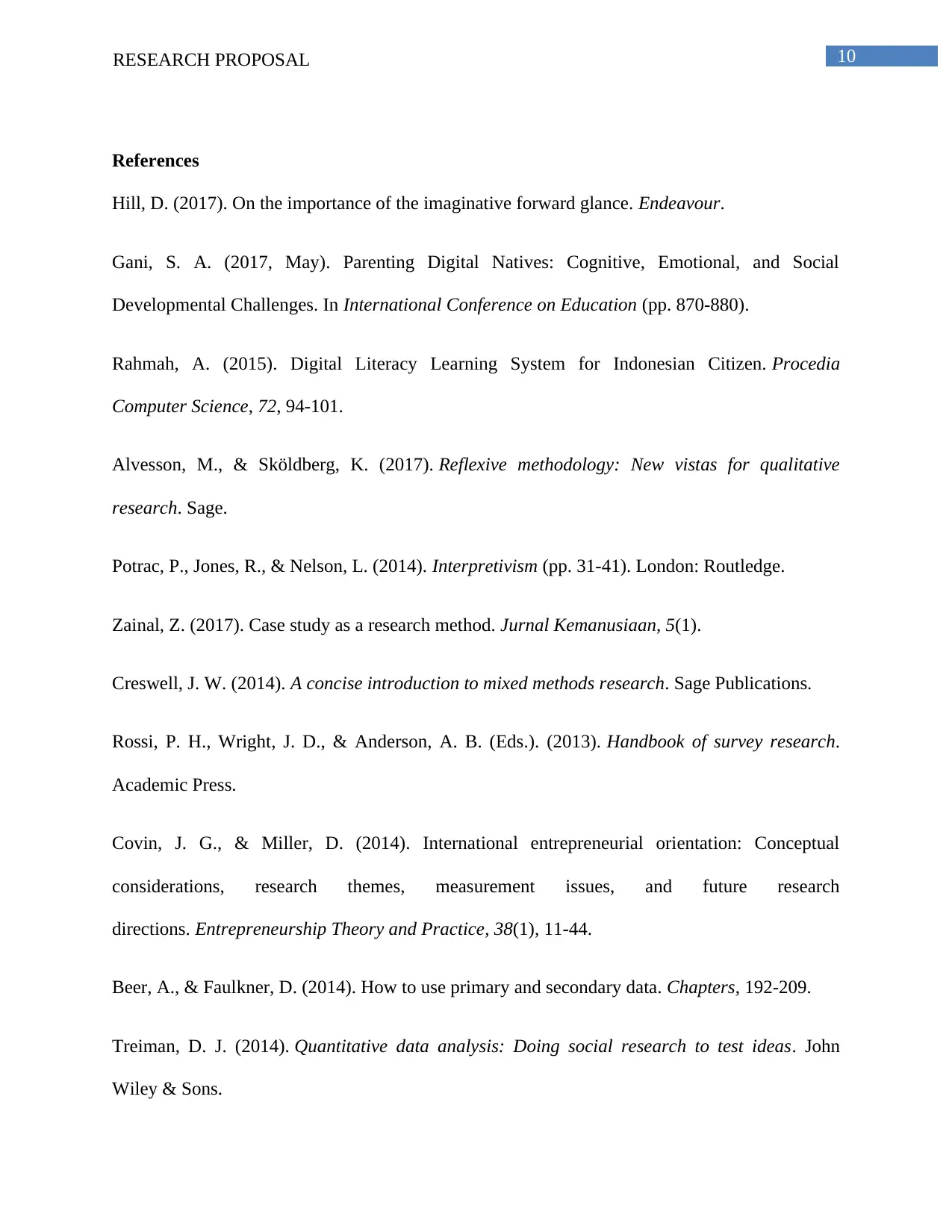
10RESEARCH PROPOSAL
References
Hill, D. (2017). On the importance of the imaginative forward glance. Endeavour.
Gani, S. A. (2017, May). Parenting Digital Natives: Cognitive, Emotional, and Social
Developmental Challenges. In International Conference on Education (pp. 870-880).
Rahmah, A. (2015). Digital Literacy Learning System for Indonesian Citizen. Procedia
Computer Science, 72, 94-101.
Alvesson, M., & Sköldberg, K. (2017). Reflexive methodology: New vistas for qualitative
research. Sage.
Potrac, P., Jones, R., & Nelson, L. (2014). Interpretivism (pp. 31-41). London: Routledge.
Zainal, Z. (2017). Case study as a research method. Jurnal Kemanusiaan, 5(1).
Creswell, J. W. (2014). A concise introduction to mixed methods research. Sage Publications.
Rossi, P. H., Wright, J. D., & Anderson, A. B. (Eds.). (2013). Handbook of survey research.
Academic Press.
Covin, J. G., & Miller, D. (2014). International entrepreneurial orientation: Conceptual
considerations, research themes, measurement issues, and future research
directions. Entrepreneurship Theory and Practice, 38(1), 11-44.
Beer, A., & Faulkner, D. (2014). How to use primary and secondary data. Chapters, 192-209.
Treiman, D. J. (2014). Quantitative data analysis: Doing social research to test ideas. John
Wiley & Sons.
References
Hill, D. (2017). On the importance of the imaginative forward glance. Endeavour.
Gani, S. A. (2017, May). Parenting Digital Natives: Cognitive, Emotional, and Social
Developmental Challenges. In International Conference on Education (pp. 870-880).
Rahmah, A. (2015). Digital Literacy Learning System for Indonesian Citizen. Procedia
Computer Science, 72, 94-101.
Alvesson, M., & Sköldberg, K. (2017). Reflexive methodology: New vistas for qualitative
research. Sage.
Potrac, P., Jones, R., & Nelson, L. (2014). Interpretivism (pp. 31-41). London: Routledge.
Zainal, Z. (2017). Case study as a research method. Jurnal Kemanusiaan, 5(1).
Creswell, J. W. (2014). A concise introduction to mixed methods research. Sage Publications.
Rossi, P. H., Wright, J. D., & Anderson, A. B. (Eds.). (2013). Handbook of survey research.
Academic Press.
Covin, J. G., & Miller, D. (2014). International entrepreneurial orientation: Conceptual
considerations, research themes, measurement issues, and future research
directions. Entrepreneurship Theory and Practice, 38(1), 11-44.
Beer, A., & Faulkner, D. (2014). How to use primary and secondary data. Chapters, 192-209.
Treiman, D. J. (2014). Quantitative data analysis: Doing social research to test ideas. John
Wiley & Sons.
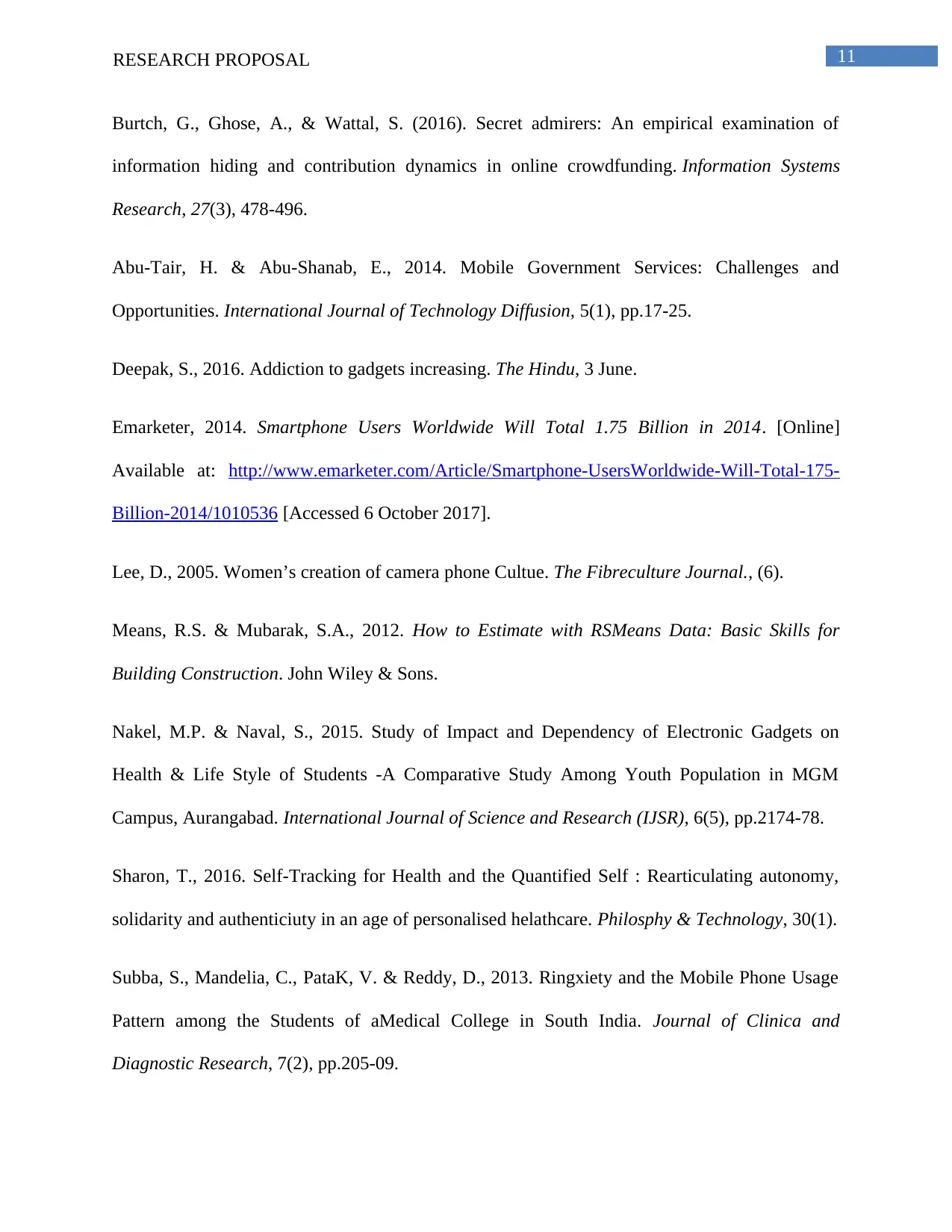
11RESEARCH PROPOSAL
Burtch, G., Ghose, A., & Wattal, S. (2016). Secret admirers: An empirical examination of
information hiding and contribution dynamics in online crowdfunding. Information Systems
Research, 27(3), 478-496.
Abu-Tair, H. & Abu-Shanab, E., 2014. Mobile Government Services: Challenges and
Opportunities. International Journal of Technology Diffusion, 5(1), pp.17-25.
Deepak, S., 2016. Addiction to gadgets increasing. The Hindu, 3 June.
Emarketer, 2014. Smartphone Users Worldwide Will Total 1.75 Billion in 2014. [Online]
Available at: http://www.emarketer.com/Article/Smartphone-UsersWorldwide-Will-Total-175-
Billion-2014/1010536 [Accessed 6 October 2017].
Lee, D., 2005. Women’s creation of camera phone Cultue. The Fibreculture Journal., (6).
Means, R.S. & Mubarak, S.A., 2012. How to Estimate with RSMeans Data: Basic Skills for
Building Construction. John Wiley & Sons.
Nakel, M.P. & Naval, S., 2015. Study of Impact and Dependency of Electronic Gadgets on
Health & Life Style of Students -A Comparative Study Among Youth Population in MGM
Campus, Aurangabad. International Journal of Science and Research (IJSR), 6(5), pp.2174-78.
Sharon, T., 2016. Self-Tracking for Health and the Quantified Self : Rearticulating autonomy,
solidarity and authenticiuty in an age of personalised helathcare. Philosphy & Technology, 30(1).
Subba, S., Mandelia, C., PataK, V. & Reddy, D., 2013. Ringxiety and the Mobile Phone Usage
Pattern among the Students of aMedical College in South India. Journal of Clinica and
Diagnostic Research, 7(2), pp.205-09.
Burtch, G., Ghose, A., & Wattal, S. (2016). Secret admirers: An empirical examination of
information hiding and contribution dynamics in online crowdfunding. Information Systems
Research, 27(3), 478-496.
Abu-Tair, H. & Abu-Shanab, E., 2014. Mobile Government Services: Challenges and
Opportunities. International Journal of Technology Diffusion, 5(1), pp.17-25.
Deepak, S., 2016. Addiction to gadgets increasing. The Hindu, 3 June.
Emarketer, 2014. Smartphone Users Worldwide Will Total 1.75 Billion in 2014. [Online]
Available at: http://www.emarketer.com/Article/Smartphone-UsersWorldwide-Will-Total-175-
Billion-2014/1010536 [Accessed 6 October 2017].
Lee, D., 2005. Women’s creation of camera phone Cultue. The Fibreculture Journal., (6).
Means, R.S. & Mubarak, S.A., 2012. How to Estimate with RSMeans Data: Basic Skills for
Building Construction. John Wiley & Sons.
Nakel, M.P. & Naval, S., 2015. Study of Impact and Dependency of Electronic Gadgets on
Health & Life Style of Students -A Comparative Study Among Youth Population in MGM
Campus, Aurangabad. International Journal of Science and Research (IJSR), 6(5), pp.2174-78.
Sharon, T., 2016. Self-Tracking for Health and the Quantified Self : Rearticulating autonomy,
solidarity and authenticiuty in an age of personalised helathcare. Philosphy & Technology, 30(1).
Subba, S., Mandelia, C., PataK, V. & Reddy, D., 2013. Ringxiety and the Mobile Phone Usage
Pattern among the Students of aMedical College in South India. Journal of Clinica and
Diagnostic Research, 7(2), pp.205-09.
⊘ This is a preview!⊘
Do you want full access?
Subscribe today to unlock all pages.

Trusted by 1+ million students worldwide
1 out of 13
Related Documents
Your All-in-One AI-Powered Toolkit for Academic Success.
+13062052269
info@desklib.com
Available 24*7 on WhatsApp / Email
![[object Object]](/_next/static/media/star-bottom.7253800d.svg)
Unlock your academic potential
Copyright © 2020–2025 A2Z Services. All Rights Reserved. Developed and managed by ZUCOL.





